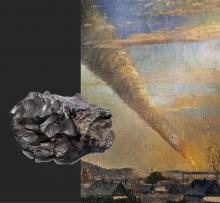Listen to today's episode of StarDate on the web the same day it airs in high-quality streaming audio without any extra ads or announcements. Choose a $8 one-month pass, or listen every day for a year for just $30.
You are here
Meteorites
Not every rock on Earth is from Earth. Some of them came from asteroids, the Moon, and even Mars. In all, about 60,000 of these space rocks have been confirmed.
Meteorites have survived the fiery plunge through Earth’s atmosphere to reach the ground. Some of them had orbited the Sun on their own since the birth of the solar system. Others were blasted off the surfaces of other bodies. More than 200, in fact, came from Mars, and almost 400 from the Moon.
Meteorites fit into several broad categories. The most common are known as chondrites. They contain small pebbles of molten rock cemented together with other materials. The spheres probably formed in the early solar system, in the asteroid belt.
A second category is achondrites. They consist mainly of once-molten rock. They probably are chips off the crusts of asteroids or other layered bodies.
Another category is iron meteorites. They consist almost entirely of metals – mainly iron, with a large fraction of nickel. And the final category is a mixture of rock and metal, called stony irons.
It’s hard to tell a meteorite from an Earth rock just by looking. Some have a dark crust – a result of their fiery journey through the atmosphere. Others are magnetic. But it generally takes an expert to identify them.
Scientists study these rocks to learn about the birth and evolution of the solar system. And they’re especially keen to find meteorites that have just fallen to Earth. More about that tomorrow.
Script by Damond Benningfield





